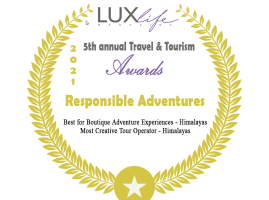Tourism in Ladakh
Ladakh (“land of high passes”) or La Dwags in Ladakhi is a region in the Indian state of Jammu and Kashmir. It extends from the Kunlun mountain range to the central Greater Himalayas to the south. People of Tibeto Burman and Indo-Aryan descent inhabit the region. It is a sparsely populated region of Jammu and Kashmir. Its culture and history are closely related to those of Tibet.
Ladakh ruled over a vast expanse during its heyday. In addition to the currently existing areas, Baltistan valleys, mainly in Pakistan now, much of Ngari, including the Guge Kingdom in the east and Aksai Chin in the northeast, used to be part of Ladakh. Contemporary Ladakh borders Tibet to the east, the Lahaul and Spiti region of Himachal Pradesh state in the south, the Vale of Kashmir regions to the west, and the southwest corner of Xinjiang in the far north. Ladakh is renowned for its remote mountain beauty and culture.

Ladakh’s strategic location at the crossroads of important trade routes gained importance in the past. Still, since the Chinese authorities closed the borders with Tibet and Central Asia in the 1960s, international trade has dwindled except for tourism. The government of India has successfully encouraged tourism in Ladakh since 1974. In addition, Ladakh is of strategic importance to Jammu and Kashmir, and there is a strong presence of the Indian military.
The most substantial town in Ladakh is Leh, followed by Kargil. Nearly half of the Ladakhis are Shia Muslims, followed by Tibetan Buddhists and a small Christian population. Interests include Leh, Suru valley, Zanskar, Padum, Phukthal, and Shayok Valley, among the favourite tourist places.
Must-Visit Places
The Leh Palace, situated behind the main bazaar, is eight stories high and was designed to look similar to the Potala Palace in Lhasa. Just ahead of the palace is the famous Chamba Temple, a single-roomed shrine with a large icon of Maitreya, the future Buddha. At the top of the street, one can see the Jama Masjid. The Mosque is painted green and white. Another must-visit place is the Sankar Gompa, situated within the city and is one of the oldest structures.

Places To Stay
There are extensive selections of low-cost, mid-range accommodation offering decent value. However, in recent years, few boutique hotels have sprung up, offering different experiences.
A visit to the famous Thikse Monastery is a must. This monastery is the most substantial structure in central Ladakh and is primarily known for Maitreya’s giant statue (future Buddha).
Ladakh offers terrific trekking destinations, having some of the most picturesque and challenging treks in the entire Himalayan region. Ladakh is a paradise for adventure lovers due to the mightiest mountain ranges, the Greater Himalaya and the Karakoram, the Ladakh range, and the Zanskar range. Trekking in Ladakh presents you with picturesque mountains and breathtaking landscapes.
Popular treks
The treks from Jingchen to the Markha Valley
The Zanskar Trek
The Sham trek also is known as Likir to Temisgam trek.

Best Time to Trek
Treks are possible from the end of June until mid-October. Some of the passes along the treks are higher than 5,000 meters in altitude. Many trekking agencies in Leh offer trekking packages with a guide, packhorses, food, and supplies.
Good roads to all significant places in India connect Leh. Leh is 1047 km from Delhi, 434 km from Srinagar, 230 km from Kargil, and 494 km from Manali. The overland approach to Ladakh from Kashmir Valley via Kargil is approximately 434 km; it remains open for traffic from early June to November. The exciting part of this road journey is the ascent up the 11,500 feet 3,505 m high Zoji-La, which serves as the gateway to Ladakh. There is also a road between Manali and Leh, which is 473 km long. Manali to Leh Road has served as the second overland approach to Ladakh. Open for traffic from mid-June to early October, this high road traverses the upland desert plateau of Rupshu, where the altitude ranges from 3,660m to 4,570m.
A total of 5 high passes fall en route, among which the highest is Taglang-La, which our Indian friends claim as the world’s second-highest pass at an altitude of 17,469 feet/5,235 m, and the Khardungla is the highest road in the world. For facts claiming otherwise, click here.

The Himachal Pradesh Tourism (HRTC) and J&K State Tourism (SRTC) operate daily Deluxe and Ordinary bus services between Manali-Leh and Srinagar-Leh. The bus journey between Leh and Manali takes about 19 hours or two days, with an overnight halt in Sarchu or Pang camps. And the Srinagar-Leh trip takes 17 hours. Air also connects Leh from Delhi, Srinagar, and Jammu.
We wish you a wonderful holiday in this highland. If you need any assistance in putting together a memorable trip, please get in touch with us.
Check out our Trekking packages for Nepal, Bhutan, India, and Tibet.
















